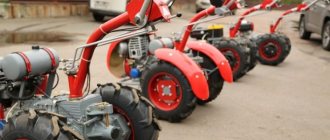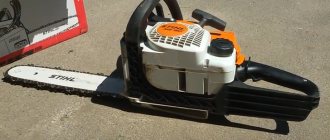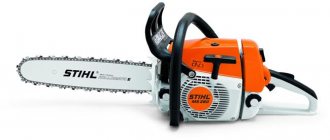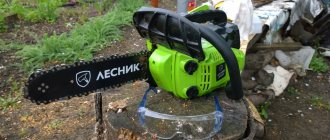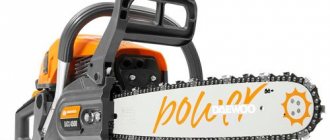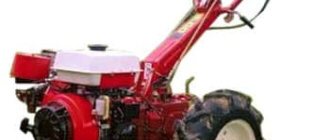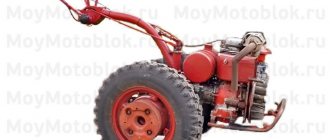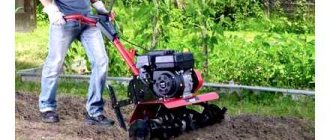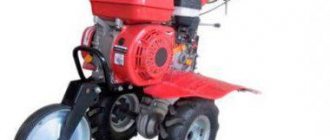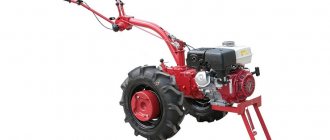Shtenli walk-behind tractors are high-quality agricultural equipment, which is manufactured taking into account innovations and the latest technologies. The product range is designed for both a professional user and a beginner who will work on a personal plot.
A worthy model from this manufacturer is the Shtenli 1900 Pro walk-behind tractor, which is very popular among consumers.
Description
The Stanley 1900 pro walk-behind tractor is produced by a German company.
Quality control of manufactured products occurs at each stage of device assembly. The manufacturer's warranty for the Shtenli 1900 pro series walk-behind tractor is 2 years. A photo of the walk-behind tractor is presented below.
This device is equipped with a four-stroke gasoline engine with a power of 18 horsepower. Stanley 1900 pro is used for processing large areas with heavy soil types. Cools the engine thanks to air flow
The Shtenli 1900 pro series starts up using a manual starter.
Model overview
Currently, you can find various models of special equipment on sale. The model range of this German manufacturer is represented by the following interesting devices:
- device number 500;
- a wonderful device version 1100 with engines of 8 and 9 horsepower;
- apparatus G-185;
- Shtenli walk-behind tractor number 900;
- Shtenli walk-behind tractor number 1030;
- device version 1600;
- fixture number G-180;
- cultivator version G-192;
- walk-behind tractor Shtenli 1900 pro;
- version number 1400;
- Stanley 1800 device.
Specifications
| Manufacturer: | Shtenli |
| Power: | 18 hp |
| Engine's type: | petrol 4-stroke |
| Drive unit: | Gear |
| Forward/reverse gears: | 3/1 |
| Fuel consumption: | 1.5 l/h |
| Processing width: | 900-1100 mm |
| Processing depth: | 150-300 mm |
| Wheel size: | 7 x 12 cm |
| PTO: | Eat |
| Weight | 175kg |
| Dimensions | 1900x1400x900 |
| Transmission | Shtenli Gear Shift 2+ (SGS 3+1) Low gear |
| Guarantee: | 24 months |
| Manufacturer country: | Germany |
Features of application
If you are the owner of a new Stanley 1900 pro walk-behind tractor, then before you start working on it, you need to assemble the device (in accordance with the user manual) and run it in:
- Fill with fuel and oil;
- Warm up the engine at idle speed;
- Gear shifting should be done smoothly and without much effort;
- When cultivating the soil for the first time, use the machine at half maximum power;
- Upon completion of break-in, change the oil.
Running in the walk-behind tractor after purchase
After purchasing the unit, it should not be immediately given maximum load. Its parts and components are not yet ground into each other. In order for the power plant, transmission and chassis to start working at full efficiency, a run-in of the walk-behind tractor is required. It must be carried out in full to avoid damage to the unit and accelerated wear of its components.
The new walk-behind tractor should be run in in the following sequence:
- Remove it from the packaging and remove all shipping tapes, stoppers and safety devices. Carry out an external inspection for damage.
- Remove the preservative with a soft cloth. Clean electrical contacts with alcohol to remove oil.
- Attach the wheels to the axle shaft. Check how freely they scroll. To do this, the body must be lifted and placed on the stop. Shift gears, make sure this unit is working properly, and lower the unit to the ground.
- Using a wrench, tighten all bolted connections on the power unit, transmission and frame. Connect the headlight to the generator.
- Unscrew the spark plug and make sure the gap is set correctly. Clean the contacts and screw the spark plug back in.
- Fill the crankcase with oil and fill the fuel tank to the maximum mark. After a few minutes, inspect the tanks for leaks.
- Start the engine and leave it idling for 20-30 minutes. All this time, monitor the condition of the crankcase and gaskets. After completing the idle run, turn off the unit and inspect it. If everything is in order, then you can continue.
Stanley 1900 device
- Unlike many analogues, the Stanley 1900 pro walk-behind tractor has not 3 gears, but 4, one of which is low.
- Many owners of walk-behind tractors with power from 8 to 18 hp. They note the inconvenience of operating the machine and the rapid progress of its operation. A low gear reduces the transmitted torque and allows you to carry out work comfortably.
- Another advantage of the Shtenli walk-behind tractor is the installed anti-vibration system, which allows you to reduce the transmitted vibration to the steering bar.
- The Stanley 1900 Pro walk-behind tractor is equipped with a powerful halogen headlight that illuminates the area at night.
Photo of Shtenli 1900 Pro walk-behind tractor
Trailers and off-road improvements
Despite the fact that the walk-behind tractor has wide wheels, and it itself has an impressive weight, this is not always enough for reliable traction with the ground. In order to prevent slipping, lugs for the walk-behind tractor are used. Their diameter is 30-60 cm, and the weight of one pair is between 40-70 kg. Ground hooks are installed in cases where plowing is carried out on loose or wet soil.
The problem of slipping can be solved without replacing the wheels with lugs. This is done with the help of weights that are installed on the axle shafts and frame of the unit.
Some walk-behind tractor owners weld a frame to its frame, into which they place containers of water or sandbags. In winter, the wheels are replaced with modular tracks, which turn the walk-behind tractor into a full-fledged snowmobile.
Increasing the ease of use of the unit and expanding its functionality is achieved by using the following towed devices:
- Adapter. Used for traveling over various distances when the road is in poor condition. The adapter relieves the load on the worker’s legs when processing large areas.
- Cargo trailers. Used during planting and harvesting work. In the local area, the use of trailers is necessary for transporting heavy things, removing garbage, and moving bulk cargo. By design, trailers are divided into single-axle and two-axle.
- Combined trolleys. They have 2 seats, a chassis and a small body. The drawbar of the trolleys is adapted for attaching attachments. You can use carts for trips to a picnic, fishing or to a rural store for shopping.
- Sled. They are used in winter for transporting people and various cargoes. By design, sleds are divided into sliding methods. You can buy sleds with a flat bottom or on runners.
With good traction and in low gear, the walk-behind tractor can tow trailers weighing up to 1000 kg. Such capabilities are used during emergency rescue operations. Stanley units successfully pull out passenger cars stuck in mud and snow, evacuate faulty equipment, motorcycles and snowmobiles. On a good flat road, walk-behind tractors with a trailer can accelerate to 18 km/h.
Service Stanley 1900
- It is necessary to monitor the condition of the Stanley walk-behind tractor and carry out regular maintenance in accordance with the user manual.
- Upon completion of work, be sure to clean the device from any remaining dirt, dust and moisture. If they accumulate for a long time, the walk-behind tractor can quickly begin to rust.
- It is necessary to clean the fuel and air filters every 5 hours of operation, since if they are clogged, the engine will begin to malfunction.
- Engine oil must be changed every 25 operating hours. For this it is recommended to use 10W-30.
- Transmission oil must be changed twice a year: in autumn and spring.
How is pressure measured and determined?
To measure the pressure in the pneumatic wheels of a walk-behind tractor and other garden equipment, purchase a pressure gauge.
Pumps with a built-in device can be used, but they are usually not very accurate. Therefore, if you use the same device to measure pressure in small wheeled vehicles and in tires, it is better to buy a high-quality pressure gauge separately. Air pressure in tires is measured in Atmospheres, Bars, Psi and Kilopascals.
The atmosphere is almost equal in size to the Bar, so in practice these units are interchangeable.
1 atm. = 1 kgf/1 cm2 = 1.02 bar.
Units of measurement are converted from one to another using the formulas:
Owner reviews
Here are the reviews left on thematic forums regarding the operating experience of the Stanley walk-behind tractor:
Kirill:
“I have a plot of 15 acres. I regularly work with cutters and do work with potatoes.
Among the advantages of the Stanley Pro are low fuel consumption, high weight and power, and the presence of a low gear.
But one of the disadvantages is the unclear operating instructions. They probably have a standard one, since half of the details are not indicated in it at all. Low quality metal. Many bolts do not hold and I have already replaced almost all of them with normal ones. The wires are not secured in any way and can be easily torn off.
There were problems with the ignition system, I changed the spark plug, and now it starts normally.
The impression is twofold. The quality is clearly not German, but it’s about worth the money.”
What kind of oil to pour into a walk-behind tractor engine
In order for the walk-behind tractor to work flawlessly for a long time, it must be properly maintained and operated. Oil is a key factor in keeping an engine running. We’ll try to figure out what kind of oil to pour into a walk-behind tractor engine on this page of the site.
The most correct recommendation for selecting oil will be the recommendation of the engine manufacturer for the walk-behind tractor. Therefore, we will familiarize ourselves with the operating instructions of the main manufacturers of engines for walk-behind tractors and provide excerpts from the instructions.
The choice of motor oil, like any other type of oil, depends on two main parameters - operational category and viscosity class.
CLASSIFICATION OF OIL GRADES API classification by operational categories (American Petroleum Institute). See more details here
CLASSIFICATION OF OIL GRADES BY VISCOSITY SAE classification (Society of Automotive and Transportation Engineers). See more details here
Winter - with the letter W (Winter). Oils that meet these categories are low-viscosity and are used in winter - SAE 0W, 5W, 10W, 15W, 20W, 25W
Summer - without letter designation. Oils that meet these categories are highly viscous and are used in summer - SAE 20, 30, 40, 50, 60.
Types of wheels for walk-behind tractors. Pneumatic tire pressure
The two main types of wheels used on walk-behind tractors are:
Pneumatic Steel
Both types have their own characteristics and operating conditions.
Metal wheels come in wide and narrow types and are mainly used when working with a plow and driving on dirt roads. Experienced users note as a drawback that soil sticks to them when plowing, which causes the adhesion to the surface to deteriorate sharply.
Unlike steel wheels, modern special pneumatic tires for garden equipment have a good ability to self-clean from adhering soil. And everything related to their operation, maintenance and storage fully coincides with the requirements for all other pneumatic tires.
Important! Particular attention is paid to maintaining optimal pressure in the tires of the walk-behind tractor. As practice shows, the best values for plowing can be considered 1.8-2.2 atm., when driving with a trailer - 1.5-1.8 atm.
Peculiarities
Motoblocks of the “Shtenli 1900 Pro” model are in the leading positions of their family, as they are equipped with a powerful 14 liter four-stroke gasoline engine. With. and 18 l. s., as well as a fairly well-thought-out gearbox. The equipment has a gear drive, 3 forward and one reverse speed. Weighing 175 kilograms, the unit is characterized by a processing width of 90-110 cm and a depth of 15 to 30 centimeters. A walk-behind tractor with a low gear facilitates the comfortable performance of a variety of jobs.
The advantages of the machine include the installed anti-vibration system, which helps reduce vibrations on the steering hose. "Shtenli 1900 Pro" has a powerful halogen headlight, thanks to which it can be used in the dark.
The unit has an optimal length of a hexagonal shaft, a cast-iron gear reducer with a bevel gear. Also, the advantages of the unit are the presence of a convenient glove compartment, as well as the ability to adjust the handle to suit any height.
Features of the Shtenli 1900 Pro Series walk-behind tractor
- five bypass valves on the engine, which improve fuel distribution during operation of the Stanley walk-behind tractor;
- gearbox - modified, type Shtenli Gear Shift 2+, provides smooth gear shifting without jerking;
- the decompression valve is equipped with an easy start function;
- vibration suppression system that stabilizes the handles for operator safety;
- universal type mount;
- dry clutch, easy to maintain and optimal in operation;
- large wheels that give additional stability to the device;
- lower gear, simplifying the operator’s work with the walk-behind tractor without loss of functionality.
The listed technical features make the Shtenli 1900 Pro Series walk-behind tractor popular among farmers and owners of greenhouses, vegetable gardens, and personal plots.
In addition to technical equipment, the Shtenli walk-behind tractor has an attractive design and high quality of all connections. Thanks to the presence of a low gear, even at low speeds the device can retain more power.
Correct operation and maintenance
Each user of a walk-behind tractor must be able to use it correctly. To do this, each product is accompanied by an instruction manual, which describes in detail the principles of its use. Replacing the clutch, adjusting the carburetor, adjusting the plow, unlocking the wheels are simple processes that every owner can do.
The basic rules for operating the Shtenli 1900 Pro are as follows:
- running-in for 8 hours, while the engine load should be at 2/3 power;
- in the winter period of the year it is worth using synthetic oil for the walk-behind tractor, and in the summer - semi-synthetic;
- oil must be added after every 50 operating hours;
- for storage, the unit must be left with a previously emptied tank and oil sump;
- the machine must be stored in a room with a positive temperature;
- Spark plugs and oil filters must be cleaned or replaced annually.
Calculation of the recommended value
How to use the calculator?
The calculator is working in test mode! If you find an error in the indicators or want to leave suggestions, please send them through the feedback form on the Feedback page or the VK group! Errors with evidence (photos, screenshots, links) are accepted! All information presented on the site is for informational purposes only! Thanks for understanding!
Contents
Troubleshooting
The most common problems encountered by walk-behind tractor users.
- Reduced engine power . The reason for this situation could be a clogged carburetor, cylinder, muffler, air hose or gas hose, so they should be thoroughly cleaned. In a situation where a decrease in power occurred after long-term storage, it is necessary to start the unit and run it idle for a while. If there is no compression, it is worth replacing the piston rings or cylinder.
- Lack of engine response to starting . The reason for this situation may be the tilt of the engine, which should be placed in a horizontal position. If the filter or tank opening is clogged, they should be cleaned. The problem may be hidden in the spark plug; to do this, it is worth checking the wires, as well as the stop button. Don't forget about cleaning or replacing candles.
- The engine operates intermittently and stalls . To begin with, the engine should be warmed up well. After this, clean the spark plugs or replace the magneto.
- The idle speed is unstable . The reason for this malfunction may be based on the large gap between the cover and the gearbox. In order to fix the problem, it is worth making the gap smaller.
- Smoke from the walk-behind tractor . This situation may arise due to poor quality gasoline or excessive tilt of the unit.
- The starter makes noise and the cord falls out . The squealing noise of the machine may be due to excessive grease on the balls, which should be cleaned thoroughly. If you hear the starter popping, then the problem may lie in the fact that the power system cannot perform its tasks efficiently.
To improve the functioning of the walk-behind tractor, it is necessary to remove debris from the valve and air filter.
Equipment maintenance tips
If you pay due attention to the wheels of a walk-behind tractor, the service life of them, as well as other components and parts of the machine, will significantly increase. Therefore, you should adhere to a few simple rules:
- When installing walk-behind tractor tires with a directional tread pattern, pay attention to the arrow marking on the sidewall of the tire. It indicates the direction of rotation that will provide the best traction and maximum traction;
- Do not allow the walk-behind tractor to operate with reduced air pressure in the tires. Because of this, creases may appear on the rubber and the cord may peel off. Wheel slip is possible. In addition, gasoline consumption during such operation will increase;
- increased pressure is also undesirable, it will lead to premature wear of the tread;
- If adhesion to loose soil is insufficient, you should not increase the pressure gauge readings to improve it. In this case, special weights are hung on the wheels;
- for greater stability of the machine on uneven ground and increased ground clearance when working on tall crops, larger diameter wheels are installed in place of the drive ones;
- Every time after work, clean the lugs of the walk-behind tractor from adhering soil, stuck stones and foreign objects. Keep equipment in a dry, ventilated area;
- During long-term storage, the walk-behind tractor should be suspended or placed on supports so that its wheels do not touch the ground. During storage, tires are inflated to 2 atm to avoid cracking and premature aging of the rubber.
Important! On tires, the manufacturer indicates the maximum permissible pressure parameters for a given rubber. These values are not recommendations for tire inflation. They are usually too high!
Source
Attachments
The complete set of the walk-behind tractor, in addition to the unit itself, includes rubber wheels, cutters, a universal hitch, a step, a set of tools and spare parts, and instructions. Each owner of the Shtenli 1900 Pro has the opportunity to improve the unit by adding attachments to it.
The most common attachments for walk-behind tractors:
- hillers;
- plows;
- potato diggers;
- potato planters;
- trailers;
- adapters with seat;
- water pumps;
- ground hooks;
- seeders;
- additional cutters;
- metal wheels;
- rotary mowers.
Reviews
Many people who own land have given preference to the Shtenli 1900 Pro walk-behind tractor. User reviews indicate economical fuel consumption, good power, as well as high-quality steering wheel mounting. Also, people who use these units are satisfied with the long service life, as well as the high-quality processing of virgin and heavy soils.
The machines do a good job of planting and digging up root crops, mowing the grass and tidying up the area.
"Shtenli 1900 Pro" are high-quality and durable units. Some reviews contain information about minor problems, as well as low-quality hubs and differentials. A small number of users have questions about the operating instructions, which do not contain all the necessary information.
When purchasing this type of equipment, you can get a reliable assistant who will help you take care of the territory at any time of the year. This purchase quickly pays for itself, the machines are easy to use, multifunctional, have high-quality assembly and cope with all tasks perfectly. A walk-behind tractor with a low gear requires proper care, running-in, careful use, as well as high-quality fuel.
For an overview of the characteristics and operating rules of the Shtenli 1900 Pro walk-behind tractor, see the following video.

